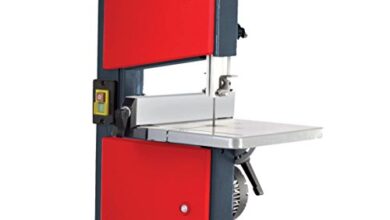That you have to keep in mind when buying a bank screw

A vise is an accessory that is attached to the work table and serves to keep the workpiece fixed to the surface, but today there is a wide variety of models that differ in their designs, installation systems, holding capabilities, among other features to consider before choosing a model.
Important features of the vise
It is necessary to first define the use that you will give the vise, since if you plan to use it at home or in a small private workshop, you may not have to spend a lot of money on it, however, those for professional use they are capable of holding very heavy loads but can cost more.
Regarding the dimensions, the width is the most outstanding aspect, because the wider the jaw, the greater the span and depth to work with pieces of different shapes and sizes. For seldom used vices, a width between 100mm and 140mm might suffice, but professionals should have 140mm to 200mm to ensure optimal clamping on large workpieces, plus this provides more versatility for use in different types of projects.
The manufacturing materials directly influence the price, durability and resistance of the tool, so if you are looking for a cheap option, models made of steel or other types of cast metals could provide you with the necessary quality. On the other hand, those models made with forged metals are more robust and offer a longer useful life.

Installing a vise
Both professionals and amateurs agree on the importance of correct placement of the vise, so it is important to follow a series of measures to ensure its effectiveness. In principle, you should choose an area on your work table where it does not reduce comfort to perform other tasks, in this sense, having a lot of space around the vise can be essential to later fix large parts and materials, either a sheet of wood or a long tube.
In addition, it is recommended to install it in the area near the table legs, since normally in these points the bench provides greater stability and strength. Depending on the measurements of the table, it may also be more comfortable to attach the screw to the table on the left side if you are right-handed or on the right side if you are left-handed, in this way, it will allow you to move freely.
To carry out the assembly, you must drill the fastening holes to the bench, it is important that the diameter of the drill is 2 mm greater than the diameter of the screws that you will use to fix the bench vise (in this link you will find several products to choose from), since so that the piece cannot be tilted, offering a more secure support. In the same way, the clamp must protrude from the table, because this allows to fix pieces vertically, be it a table, tube or other type of material.
Today’s Top 5 Bench Vices
Stanley 1-83-068 MaxSteel
It is one of the most popular vise among construction professionals, since it is made of solid steel, which gives it a maximum level of resistance to hold all types of materials without diminishing its durability. Likewise, it has a weight of 15 kilograms, which you should consider before its installation, because the work surface must have the capacity to support not only this weight, but also that of the pieces, to achieve a good level of stability.. It features a 150mm wide jaw, which is the standard capacity for use with most materials. As if that were not enough, it has a gripping force of 2200 kg for greater effectiveness.
TecTake 125
This is a classic vise that is average weight and sturdy in design, making it a sturdy tool capable of providing security and strength for holding large objects. In this sense, it has a wide jaw of 125 mm, but you can get it in its presentation of up to 165 mm, which is more effective for use in demanding jobs. On the other hand, it is made of solid cast iron, so it can be used in carpentry workshops and in DIY projects.

Silverline VC17
It is one of the cheapest models in the selection, which also weighs less than 1 kg, so it is mainly indicated for the use of enthusiasts or apprentices. Likewise, its jaws offer a width of 70 mm and are made of rubber, so its fastening to the different materials is comfortable and safe so as not to damage them. As if that were not enough, its head can rotate up to 360° and tilt up to 45°, so you can adapt it to the layout of the pieces.
Mannesmann M 712-125
It is a vise that weighs only 7 kilograms and has dimensions of 30.6 x 15 x 14.6 cm, so you can install it comfortably, in addition, it has 2 holes of 10 mm in diameter to fix it immediately. On the other hand, it offers security and confidence to professionals to use it in low and medium intensity tasks, in the same way, it has removable jaws of 100 x 18 mm, capable of opening from 0 to 125 mm.
Stanley 1-83-069
This is a multi-angle design model, which means that you can position it at different angles for greater versatility, it also does not cost much money, so it can be the right complement to use in small home workshops. Its jaw is 75 mm wide and has a force of 25 kg, for this reason, you can only use it to hold small objects and materials that do not require great force. It also has a rubber covered jaw to ensure efficient and gentle clamping of work pieces.



